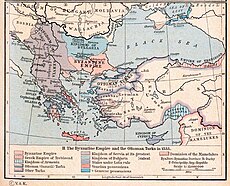
A | B | C | D | E | F | G | H | CH | I | J | K | L | M | N | O | P | Q | R | S | T | U | V | W | X | Y | Z | 0 | 1 | 2 | 3 | 4 | 5 | 6 | 7 | 8 | 9
Army Group Serbia
...44°49′N 20°27′E / 44.817°N 20.450°E
Territory of the Military Commander in Serbia Gebiet des Militärbefehlshabers in Serbien | |||||||||
|---|---|---|---|---|---|---|---|---|---|
| 1941–1944 | |||||||||
 The Territory of the Military Commander in Serbia within Europe, circa 1942 | |||||||||
 | |||||||||
| Status | Territory under German military administration | ||||||||
| Capital | Belgrade | ||||||||
| Common languages | German Serbian | ||||||||
| Government | Military government | ||||||||
| Military Commander | |||||||||
• Apr–Jun 1941 | Helmuth Förster | ||||||||
• Jun–Jul 1941 | Ludwig von Schröder | ||||||||
• Jul–Sep 1941 | Heinrich Danckelmann | ||||||||
• Sep–Dec 1941 | Franz Böhme | ||||||||
• 1941–1943 | Paul Bader | ||||||||
• 1943–1944 | Hans Felber | ||||||||
| Prime Minister (of puppet government) | |||||||||
• 1941 | Milan Aćimović | ||||||||
• 1941–1944 | Milan Nedić | ||||||||
| Historical era | World War II | ||||||||
• Established | 22 April 1941 | ||||||||
| 20 October 1944 | |||||||||
| Population | |||||||||
• 1941[1] | 4,500,000 | ||||||||
| Currency | Serbian dinar Reich credit note | ||||||||
| |||||||||
| Today part of | Serbia Kosovo | ||||||||
| |||||||||



